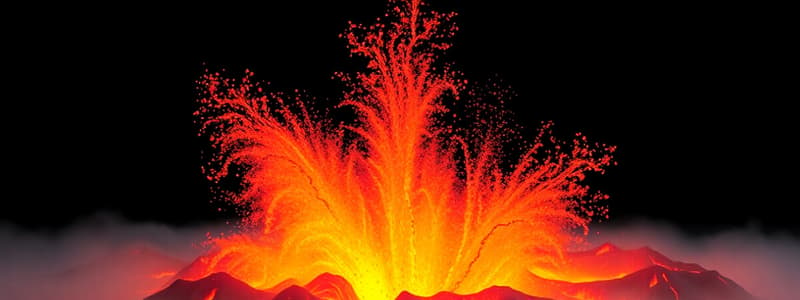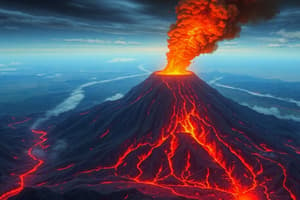Podcast
Questions and Answers
Which elements primarily compose the common silicate minerals found in Earth's crust?
Which elements primarily compose the common silicate minerals found in Earth's crust?
- Aluminum and magnesium
- Iron and nickel
- Oxygen and silicon (correct)
- Calcium and sodium
What is the main characteristic of granite regarding its mineral composition?
What is the main characteristic of granite regarding its mineral composition?
- It is composed of only metallic minerals.
- It contains various silicate minerals. (correct)
- It is rich in iron and magnesium.
- It contains only quartz.
What is the most common mineral group that consists of oxygen and silicon?
What is the most common mineral group that consists of oxygen and silicon?
- Silicates (correct)
- Nitrates
- Oxides
- Carbonates
In relation to the viscosity of magma, which type of magma is typically associated with higher silica content?
In relation to the viscosity of magma, which type of magma is typically associated with higher silica content?
What distinguishes volcanic (extrusive) igneous rocks from plutonic (intrusive) igneous rocks?
What distinguishes volcanic (extrusive) igneous rocks from plutonic (intrusive) igneous rocks?
What term is used to label igneous rocks that are silica-rich and dominated by light-colored minerals?
What term is used to label igneous rocks that are silica-rich and dominated by light-colored minerals?
Which of the following describes mafic igneous rocks?
Which of the following describes mafic igneous rocks?
In terms of crystallization, how do volcanic rocks typically compare to plutonic rocks?
In terms of crystallization, how do volcanic rocks typically compare to plutonic rocks?
What color are felsic igneous rocks primarily associated with?
What color are felsic igneous rocks primarily associated with?
What is the primary characteristic that distinguishes mafic rocks from felsic rocks?
What is the primary characteristic that distinguishes mafic rocks from felsic rocks?
How do geologists classify igneous rocks based on where they formed?
How do geologists classify igneous rocks based on where they formed?
Which of the following is a correct classification of an intermediate igneous rock?
Which of the following is a correct classification of an intermediate igneous rock?
What is the relationship between the silica content and the viscosity of igneous rocks?
What is the relationship between the silica content and the viscosity of igneous rocks?
Which igneous rock is identified as the plutonic equivalent of Basalt?
Which igneous rock is identified as the plutonic equivalent of Basalt?
Which of the following rocks is classified as a felsic plutonic rock?
Which of the following rocks is classified as a felsic plutonic rock?
Which mineral characteristic affects the order of melting during partial melting?
Which mineral characteristic affects the order of melting during partial melting?
Which minerals typically remain solid during the partial melting of granite?
Which minerals typically remain solid during the partial melting of granite?
In terms of viscosity, how do mafic magmas generally compare to felsic magmas?
In terms of viscosity, how do mafic magmas generally compare to felsic magmas?
What process occurs when some minerals melt while others remain solid?
What process occurs when some minerals melt while others remain solid?
What determines the type of igneous rocks that form when magma cools?
What determines the type of igneous rocks that form when magma cools?
What can the identification of minerals in igneous rocks help geologists understand?
What can the identification of minerals in igneous rocks help geologists understand?
What type of magma is likely to erupt more violently?
What type of magma is likely to erupt more violently?
What is a defining characteristic of shield volcanoes?
What is a defining characteristic of shield volcanoes?
What type of volcano is characterized by a steep triangular profile and more violent eruptions?
What type of volcano is characterized by a steep triangular profile and more violent eruptions?
Which type of lava is typically associated with composite volcanoes due to their silica-rich magma?
Which type of lava is typically associated with composite volcanoes due to their silica-rich magma?
How do shield volcanoes generally compare in size to cinder cones?
How do shield volcanoes generally compare in size to cinder cones?
What characteristic of lava from shield volcanoes allows it to travel long distances?
What characteristic of lava from shield volcanoes allows it to travel long distances?
What characteristic hazard can arise from the steep slopes of lava domes?
What characteristic hazard can arise from the steep slopes of lava domes?
Which eruption product is considered the most far-flung during a volcanic eruption?
Which eruption product is considered the most far-flung during a volcanic eruption?
What defines the majority of hazards associated with composite volcanoes?
What defines the majority of hazards associated with composite volcanoes?
Which type of volcano is primarily associated with lava production during eruptions?
Which type of volcano is primarily associated with lava production during eruptions?
What are the characteristics of lahars during a volcanic eruption?
What are the characteristics of lahars during a volcanic eruption?
What is the primary danger associated with pyroclastic flows?
What is the primary danger associated with pyroclastic flows?
Flashcards
Plutonic Igneous Rocks
Plutonic Igneous Rocks
Igneous rocks that form when magma cools and solidifies below the Earth's surface.
Volcanic Igneous Rocks
Volcanic Igneous Rocks
Igneous rocks that form when lava cools and solidifies on Earth's surface.
Texture (of Igneous Rocks)
Texture (of Igneous Rocks)
The size and arrangement of mineral crystals within a rock.
Felsic Igneous Rocks
Felsic Igneous Rocks
Signup and view all the flashcards
Mafic Igneous Rocks
Mafic Igneous Rocks
Signup and view all the flashcards
Intermediate Igneous Rocks
Intermediate Igneous Rocks
Signup and view all the flashcards
Color (as a proxy for silica content)
Color (as a proxy for silica content)
Signup and view all the flashcards
Silica Content (of Igneous Rocks)
Silica Content (of Igneous Rocks)
Signup and view all the flashcards
Silicate Minerals
Silicate Minerals
Signup and view all the flashcards
Igneous Rock Formation
Igneous Rock Formation
Signup and view all the flashcards
Magma Composition
Magma Composition
Signup and view all the flashcards
Intrusive Igneous Rocks
Intrusive Igneous Rocks
Signup and view all the flashcards
Extrusive Igneous Rocks
Extrusive Igneous Rocks
Signup and view all the flashcards
Volcanic Eruptions
Volcanic Eruptions
Signup and view all the flashcards
Weathering
Weathering
Signup and view all the flashcards
Erosion
Erosion
Signup and view all the flashcards
Sedimentary Rocks
Sedimentary Rocks
Signup and view all the flashcards
Igneous to Sedimentary
Igneous to Sedimentary
Signup and view all the flashcards
Plutonic Texture
Plutonic Texture
Signup and view all the flashcards
Volcanic Texture
Volcanic Texture
Signup and view all the flashcards
Rhyolite
Rhyolite
Signup and view all the flashcards
Granite
Granite
Signup and view all the flashcards
Andesite
Andesite
Signup and view all the flashcards
Diorite
Diorite
Signup and view all the flashcards
Basalt
Basalt
Signup and view all the flashcards
Partial Melting
Partial Melting
Signup and view all the flashcards
Multi-mineral Rocks
Multi-mineral Rocks
Signup and view all the flashcards
Silica Content and Melting Point
Silica Content and Melting Point
Signup and view all the flashcards
Partially Melted Magma
Partially Melted Magma
Signup and view all the flashcards
Peridotite
Peridotite
Signup and view all the flashcards
Amphibole
Amphibole
Signup and view all the flashcards
Magma Solidification
Magma Solidification
Signup and view all the flashcards
Petrology
Petrology
Signup and view all the flashcards
Oxygen and Silicon
Oxygen and Silicon
Signup and view all the flashcards
Quartz
Quartz
Signup and view all the flashcards
Feldspar
Feldspar
Signup and view all the flashcards
Shield Volcano
Shield Volcano
Signup and view all the flashcards
Composite Volcano
Composite Volcano
Signup and view all the flashcards
Explosive Volcanic Eruption
Explosive Volcanic Eruption
Signup and view all the flashcards
Effusive Volcanic Eruption
Effusive Volcanic Eruption
Signup and view all the flashcards
Volcanic Chain
Volcanic Chain
Signup and view all the flashcards
Cinder Cone
Cinder Cone
Signup and view all the flashcards
Lava Dome
Lava Dome
Signup and view all the flashcards
Tephra
Tephra
Signup and view all the flashcards
Volcanic Hazard
Volcanic Hazard
Signup and view all the flashcards
Pyroclastic Flows
Pyroclastic Flows
Signup and view all the flashcards
What is a lahar?
What is a lahar?
Signup and view all the flashcards
Describe a pyroclastic flow.
Describe a pyroclastic flow.
Signup and view all the flashcards
Define an effusive eruption.
Define an effusive eruption.
Signup and view all the flashcards
What is tephra?
What is tephra?
Signup and view all the flashcards
What is a lava dome?
What is a lava dome?
Signup and view all the flashcards
Study Notes
Volcanic Hazards
- Volcanic eruptions are among the most spectacular natural hazards.
- Hazards are any volcanic process that threatens life or infrastructure.
- Volcanic eruptions rarely directly consume people; instead, burial by mudflows or hot clouds of toxic gas is more common.
- Cascade volcanoes have erupted roughly once every 1-2 centuries in the past 4000 years.
- Volcanic eruptions can be violent or mild, depending on magma viscosity and gas content.
- Lahars (mudflows) are a significant hazard, can rapidly overwhelm populated areas, and have been responsible for significant loss of life.
- Tephra (volcanic debris) can cause economic disruption, block transportation routes, and create hazards for aviation.
- Lahars can be destructive and carry large quantities of debris, snow, ice, and rocks, resulting in significant damage.
Volcano Classification
- Volcanoes have recognizable characteristics based on their form.
- Shield volcanoes have gentle slopes from fluid, relatively non-explosive eruptions; composite volcanoes have steep slopes from more violent, explosive eruptions.
- Cinder cones are much smaller types of volcanoes.
- Lava domes are smaller, bulbous formations.
- Composite volcanoes are frequently associated with subduction zones where one tectonic plate slides under another.
- Shield volcanoes are often associated with hot spots, areas of elevated heat rising from deep within the Earth's mantle.
- Volcanoes can have varied sizes and shapes.
Magma Viscosity and Gas Content
- Viscosity, the resistance to flow, depends on temperature and composition.
- Higher-viscosity magma traps gases, leading to explosive eruptions.
- Lower-viscosity magma releases gases more easily, resulting in less-violent eruptions, or flows.
- Magma composition, containing dissolved gases, determines the style of eruptions.
- Silica content significantly influences magma viscosity. Higher silica content leads to higher viscosity and more explosive eruptions.
- Water content in magma can also dramatically lower its viscosity and increase explosivity.
- The amount of dissolved gases in magma also impacts explosivity, increasing dramatically as pressure decreases during ascent.
- The type of magma, volcanic products, and eruptive style can vary depending on the interaction between magma viscosity and gas content.
How Rocks Melt
- Temperature and pressure are key in determining melting conditions.
- Rocks melt at specific temperatures, determined by depth in the earth, and presence of water.
- There are different types of melting conditions: decompression melting, flux melting, and heat transfer melting.
- Decompression melting occurs when rocks are released from greater to lesser pressures, causing them to melt, commonly at ridges, and hot spots.
- Flux melting occurs at subduction zones as water-rich minerals are compressed into the mantle, causing melting of the rocks above.
- Heat transfer melting occurs when heat from the molten magma transfers to rocks above, causing melting.
- Melting can occur through decompression melting and flux melting, which are associated with specific geological settings, like oceanic ridges and subduction zones. The presence of water plays a crucial role in flux melting, significantly lowering the melting temperature of rocks.
- Different melting mechanisms, including decompression melting, flux melting, and heat transfer, affect the formation of magma in varying geological settings. Water plays a key role in lowering the melting temperatures of rocks, particularly at subduction zones.
Studying That Suits You
Use AI to generate personalized quizzes and flashcards to suit your learning preferences.



